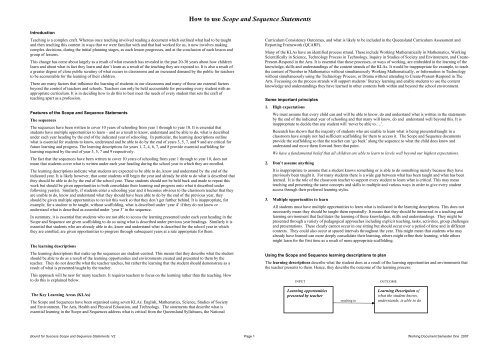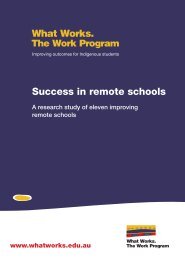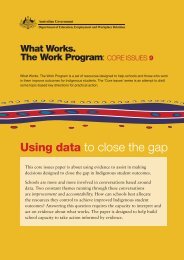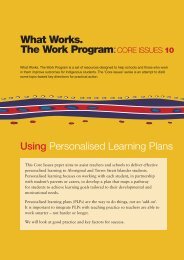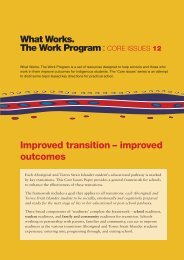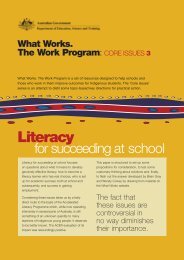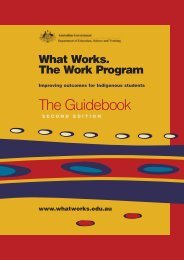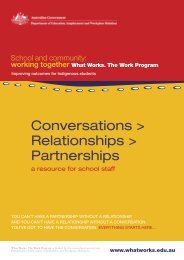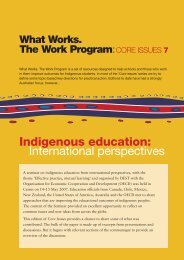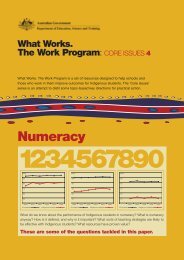Bound for Success Scope and Sequence Statements
Bound for Success Scope and Sequence Statements
Bound for Success Scope and Sequence Statements
- No tags were found...
Create successful ePaper yourself
Turn your PDF publications into a flip-book with our unique Google optimized e-Paper software.
How to use <strong>Scope</strong> <strong>and</strong> <strong>Sequence</strong> <strong>Statements</strong>IntroductionTeaching is a complex craft. Whereas once teaching involved reading a document which outlined what had to be taught<strong>and</strong> then teaching this content in ways that we were familiar with <strong>and</strong> that had worked <strong>for</strong> us, it now involves makingcomplex decisions, during the initial planning stages, as each lesson progresses, <strong>and</strong> at the conclusion of each lesson <strong>and</strong>group of lessons.This change has come about largely as a result of what research has revealed in the past 20-30 years about how childrenlearn <strong>and</strong> about what in fact they learn <strong>and</strong> don’t learn as a result of the teaching they are exposed to. It is also a result ofa greater degree of close public scrutiny of what occurs in classrooms <strong>and</strong> an increased dem<strong>and</strong> by the public <strong>for</strong> teachersto be accountable <strong>for</strong> the learning of their children.There are many factors that influence the learning of students in our classrooms <strong>and</strong> many of these are external factorsbeyond the control of teachers <strong>and</strong> schools. Teachers can only be held accountable <strong>for</strong> presenting every student with anappropriate curriculum. It is in deciding how to do this to best meet the needs of every student that sets the craft ofteaching apart as a profession.Features of the <strong>Scope</strong> <strong>and</strong> <strong>Sequence</strong> <strong>Statements</strong>The sequencesThe sequences have been written to cover 10 years of schooling from year 1 through to year 10. It is essential thatstudents have multiple opportunities to learn – <strong>and</strong> as a result to know, underst<strong>and</strong> <strong>and</strong> be able to do, what is describedunder each year heading by the end of the indicated year of schooling. In particular, the learning descriptions outlinewhat is essential <strong>for</strong> students to know, underst<strong>and</strong> <strong>and</strong> be able to do by the end of years 3, 5, 7, <strong>and</strong> 9 <strong>and</strong> are critical <strong>for</strong>future learning <strong>and</strong> progress. The learning descriptions <strong>for</strong> years 1, 2, 4, 6, 7, <strong>and</strong> 8 provide essential scaffolding <strong>for</strong>learning required by the end of year 3, 5, 7 <strong>and</strong> 9 respectively.The fact that the sequences have been written to cover 10 years of schooling from year 1 through to year 10, does notmean that students cover what is written under each year heading during the school year in which they are enrolled.The learning descriptions indicate what students are expected to be able to do, know <strong>and</strong> underst<strong>and</strong> by the end of theindicated year. It is likely however, that some students will begin the year <strong>and</strong> already be able to do what is described thatthey should be able to do by the end of the school year. These students should not be held back <strong>and</strong> made to repeat thiswork but should be given opportunities to both consolidate their learning <strong>and</strong> progress onto what it described underfollowing year(s). Similarly, if students enter a schooling year <strong>and</strong> it becomes obvious to the classroom teacher that theyare unable to do, know <strong>and</strong> underst<strong>and</strong> what they should have been able to do by the end of the previous year, theyshould be given multiple opportunities to revisit this work so that they don’t get further behind. It is inappropriate, <strong>for</strong>example, <strong>for</strong> a student to be taught, without scaffolding, what is described under ‘year 4’ if they do not know orunderst<strong>and</strong> what is described as essential under ‘year 3’ in the sequence.In summary, it is essential that students who are not able to access the learning presented under each year heading in the<strong>Scope</strong> <strong>and</strong> <strong>Sequence</strong> are given scaffolding to do so using what is described under previous year headings. Similarly it isessential that students who are already able to do, know <strong>and</strong> underst<strong>and</strong> what is described <strong>for</strong> the school year in whichthey are enrolled, are given opportunities to progress through subsequent years at a rate appropriate <strong>for</strong> them.The learning descriptionsThe learning descriptions that make up the sequences are student-centred. This means that they describe what the studentshould be able to do as a result of the learning opportunities <strong>and</strong> environments created <strong>and</strong> presented to them by theteacher. They do not describe what the teacher teaches, but rather the learning that the student should demonstrate as aresult of what is presented/taught by the teacher.This approach will be new <strong>for</strong> many teachers. It requires teachers to focus on the learning rather than the teaching. Howto do this is explained below.Curriculum Consistency Outcomes, <strong>and</strong> what is likely to be included in the Queensl<strong>and</strong> Curriculum Assessment <strong>and</strong>Reporting Framework (QCARF).Many of the KLAs have an identified process str<strong>and</strong>. These include Working Mathematically in Mathematics, WorkingScientifically in Science, Technology Process in Technology, Inquiry in Studies of Society <strong>and</strong> Environment, <strong>and</strong> Create-Present-Respond in the Arts. It is essential that these processes, or ways of working, are embedded in the learning of theknowledge, skills <strong>and</strong> underst<strong>and</strong>ings of the content str<strong>and</strong>s of the KLAs. It would be inappropriate <strong>for</strong> example, to teachthe content of Number in Mathematics without simultaneously Working Mathematically, or In<strong>for</strong>mation in Technologywithout simultaneously using the Technology Process, or Drama without attending to Create-Present-Respond in TheArts. Focussing on the process str<strong>and</strong>s will support students’ literacy learning <strong>and</strong> enable students to use the contentknowledge <strong>and</strong> underst<strong>and</strong>ings they have learned in other contexts both within <strong>and</strong> beyond the school environment.Some important principles1. High expectationsWe must assume that every child can <strong>and</strong> will be able to know, do <strong>and</strong> underst<strong>and</strong> what is written in the statementsby the end of the indicated year of schooling <strong>and</strong> that many will know, do <strong>and</strong> underst<strong>and</strong> well beyond this. It isinappropriate to decide that any student will ‘never be able to….’.Research has shown that the majority of students who are unable to learn what is being presented/taught in aclassroom have simply not had sufficient scaffolding <strong>for</strong> them to access it. The <strong>Scope</strong> <strong>and</strong> <strong>Sequence</strong> documentsprovide the scaffolding so that the teacher can ‘go back’ along the sequence to what the child does know <strong>and</strong>underst<strong>and</strong> <strong>and</strong> move them <strong>for</strong>ward from that point.We have a fundamental belief that all children are able to learn to levels well beyond our highest expectations.2. Don’t assume anythingIt is inappropriate to assume that a student knows something or is able to do something merely because they havepreviously been taught it. For many students there is a wide gap between what has been taught <strong>and</strong> what has beenlearned. It is the role of the classroom teacher to support every student to learn what is critical. This may meanteaching <strong>and</strong> presenting the same concepts <strong>and</strong> skills in multiple <strong>and</strong> various ways in order to give every studentaccess through their preferred learning styles.3. Multiple opportunities to learnAll students must have multiple opportunities to learn what is indicated in the learning descriptions. This does notnecessarily mean they should be taught them repeatedly. It means that they should be immersed in a teaching <strong>and</strong>learning environment that facilitates the learning of these knowledges, skills <strong>and</strong> underst<strong>and</strong>ings. They might bepresented through a variety of pedagogical approaches including explicit teaching, tasks, activities, group challenges<strong>and</strong> presentations. These clearly cannot occur in one sitting but should occur over a period of time <strong>and</strong> in differentcontexts. They could also occur at spaced intervals throughout the year. This might mean that students who mayalready have learned can more deeply consolidate their learning, others might refine their learning, while othersmight learn <strong>for</strong> the first time as a result of more appropriate scaffolding.Using the <strong>Scope</strong> <strong>and</strong> <strong>Sequence</strong> learning descriptions to planThe learning descriptions describe what the student does as a result of the learning opportunities <strong>and</strong> environments thatthe teacher presents to them. Hence, they describe the outcome of the learning process:INPUT OUTCOMEThe Key Learning Areas (KLAs)The <strong>Scope</strong> <strong>and</strong> <strong>Sequence</strong>s have been organised using seven KLAs: English, Mathematics, Science, Studies of Society<strong>and</strong> Environment, The Arts, Health <strong>and</strong> Physical Education, <strong>and</strong> Technology. The statements that describe what isessential learning in the <strong>Scope</strong> <strong>and</strong> <strong>Sequence</strong>s address what is critical from the Queensl<strong>and</strong> Syllabuses, the NationalLearning opportunitiespresented by teacherresulting inLearning Description ofwhat the student knows,underst<strong>and</strong>s, is able to do<strong>Bound</strong> <strong>for</strong> <strong>Success</strong> <strong>Scope</strong> <strong>and</strong> <strong>Sequence</strong> <strong>Statements</strong> V2 Page 1 Working Document Semester One 2007


